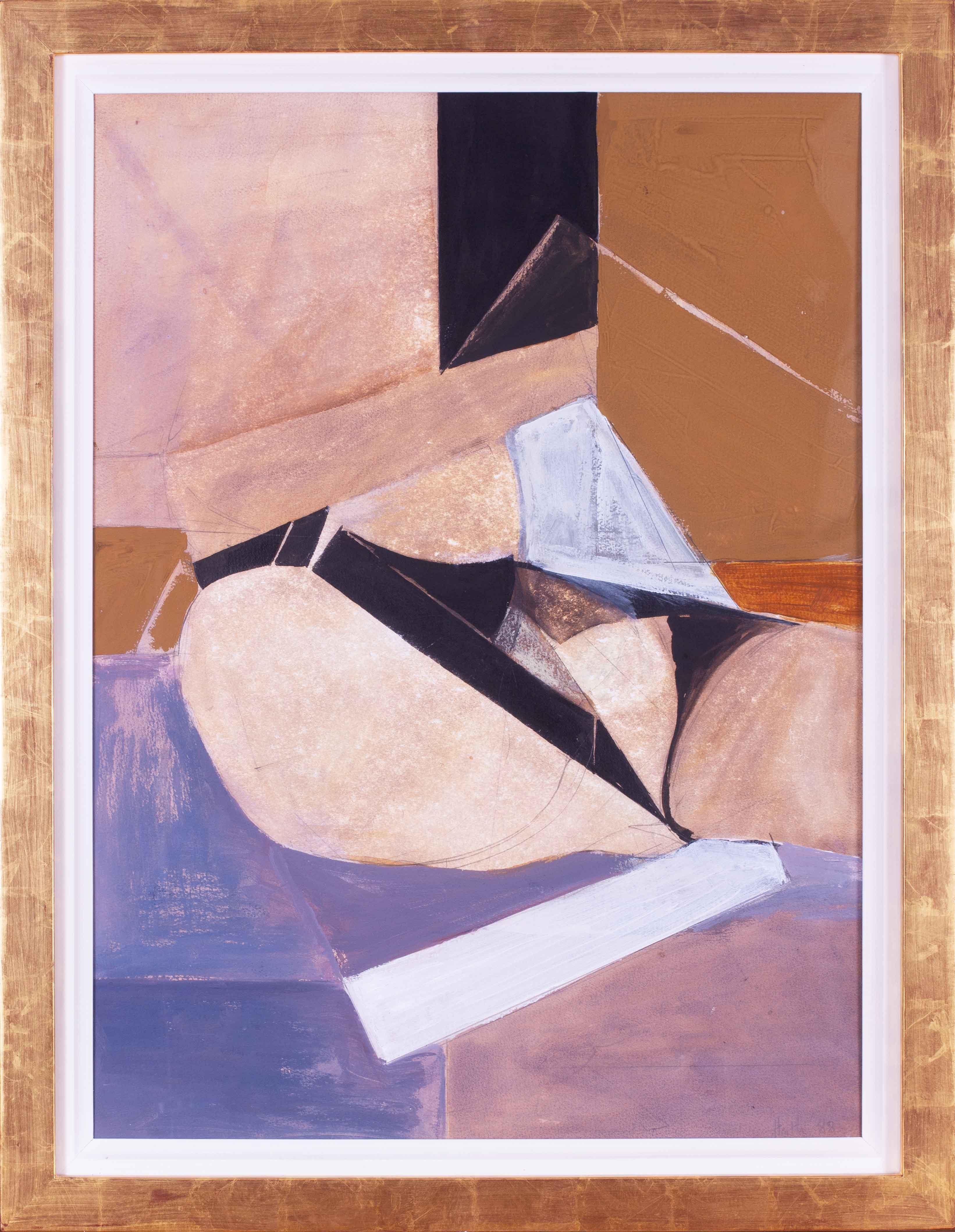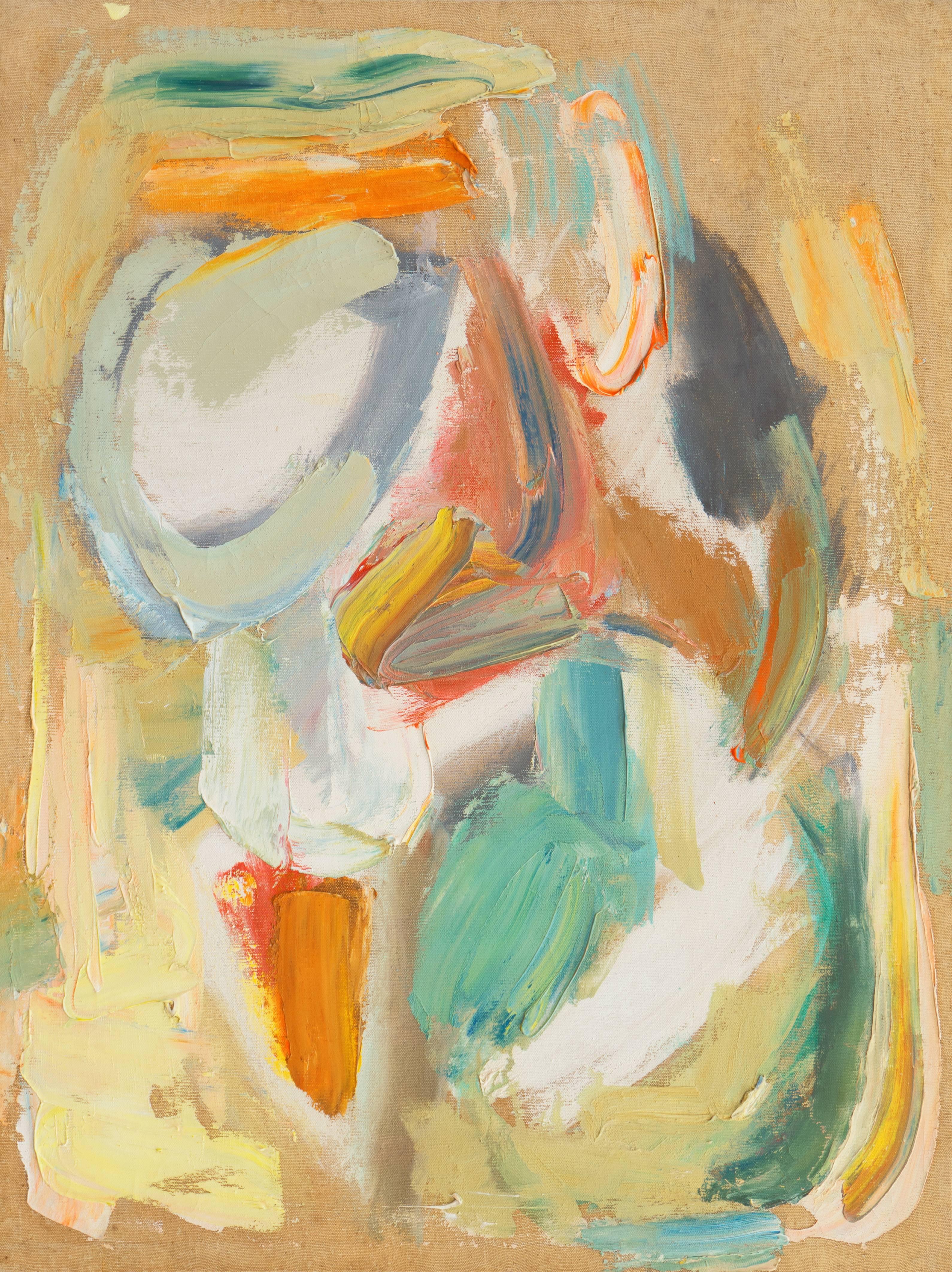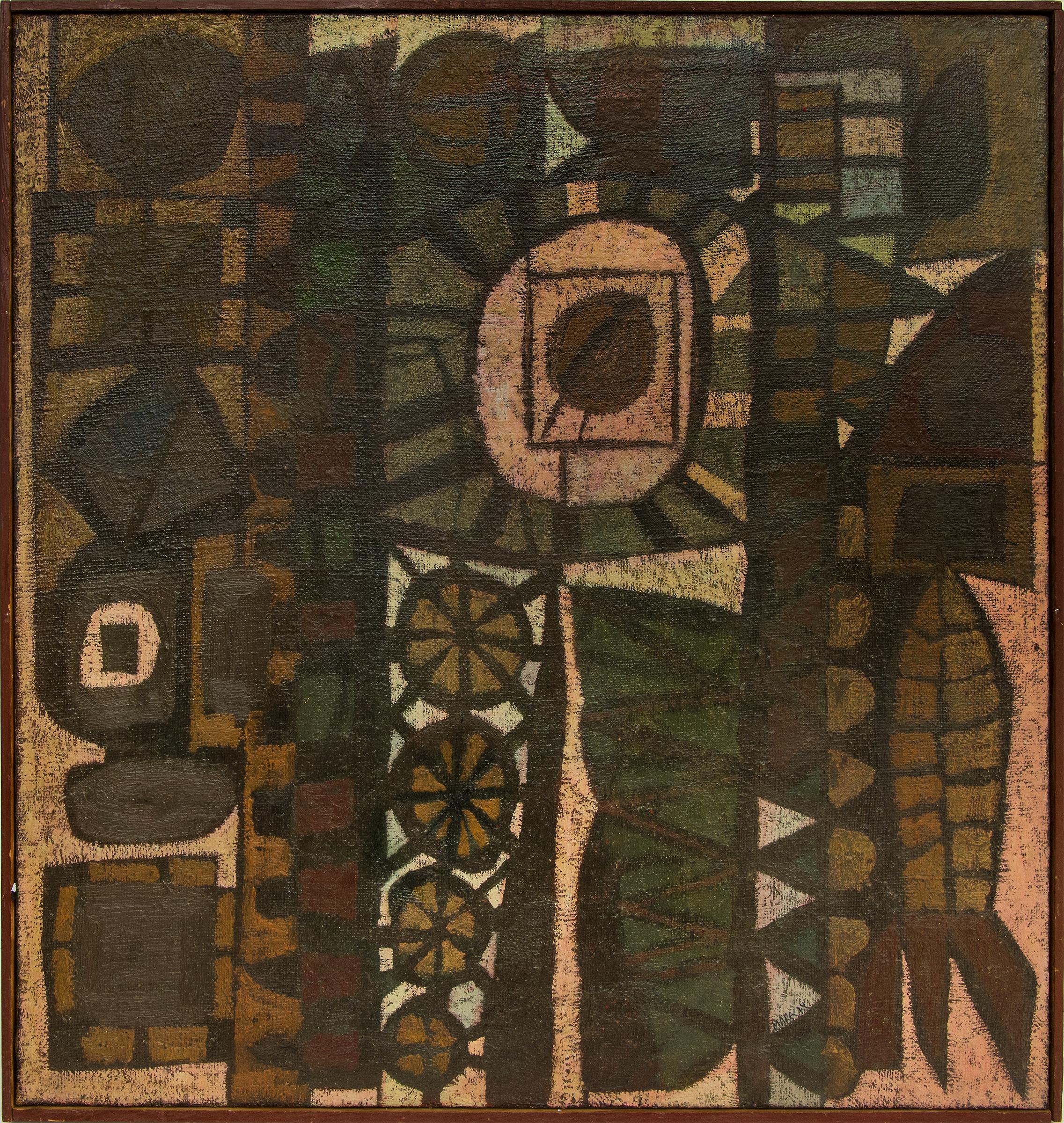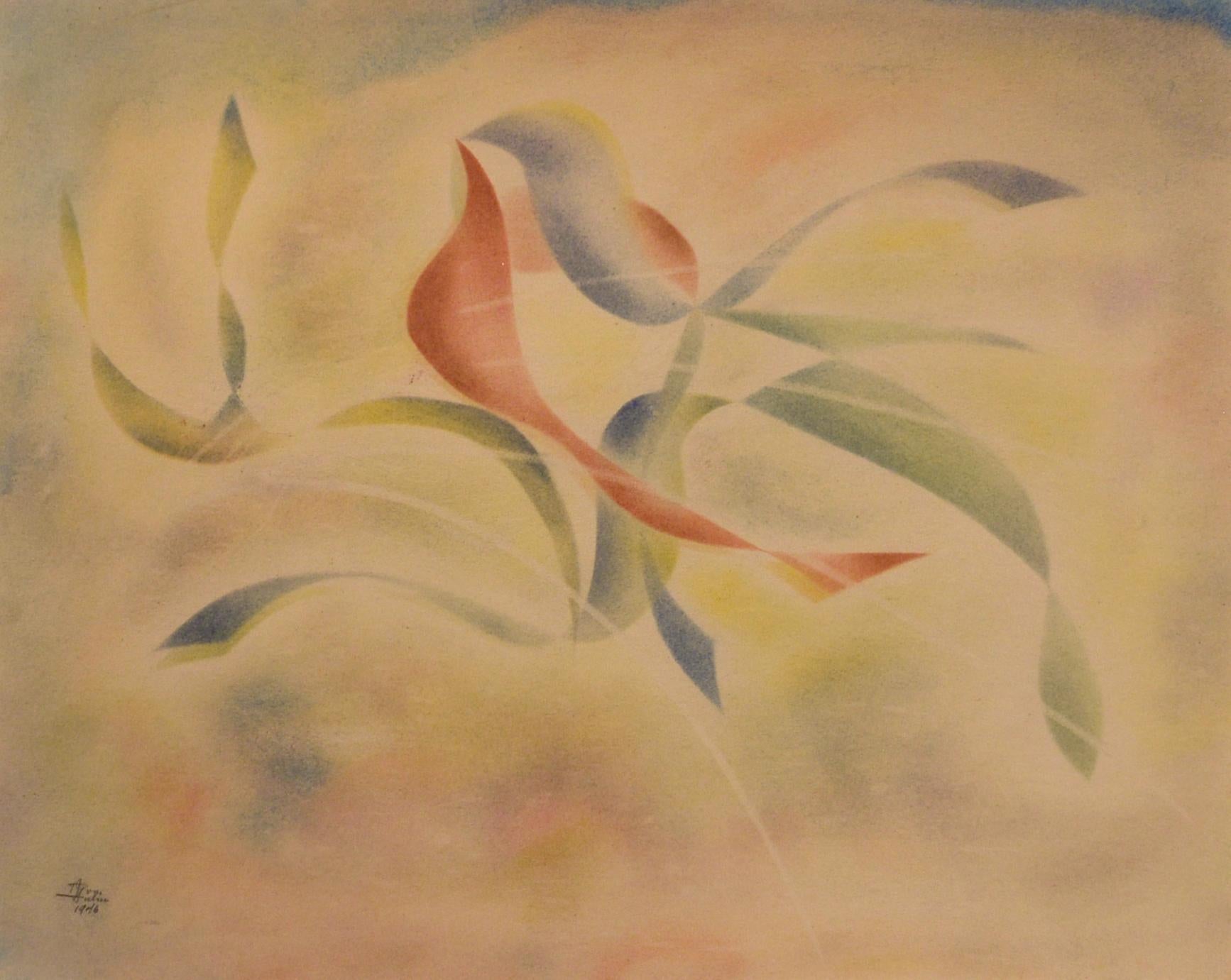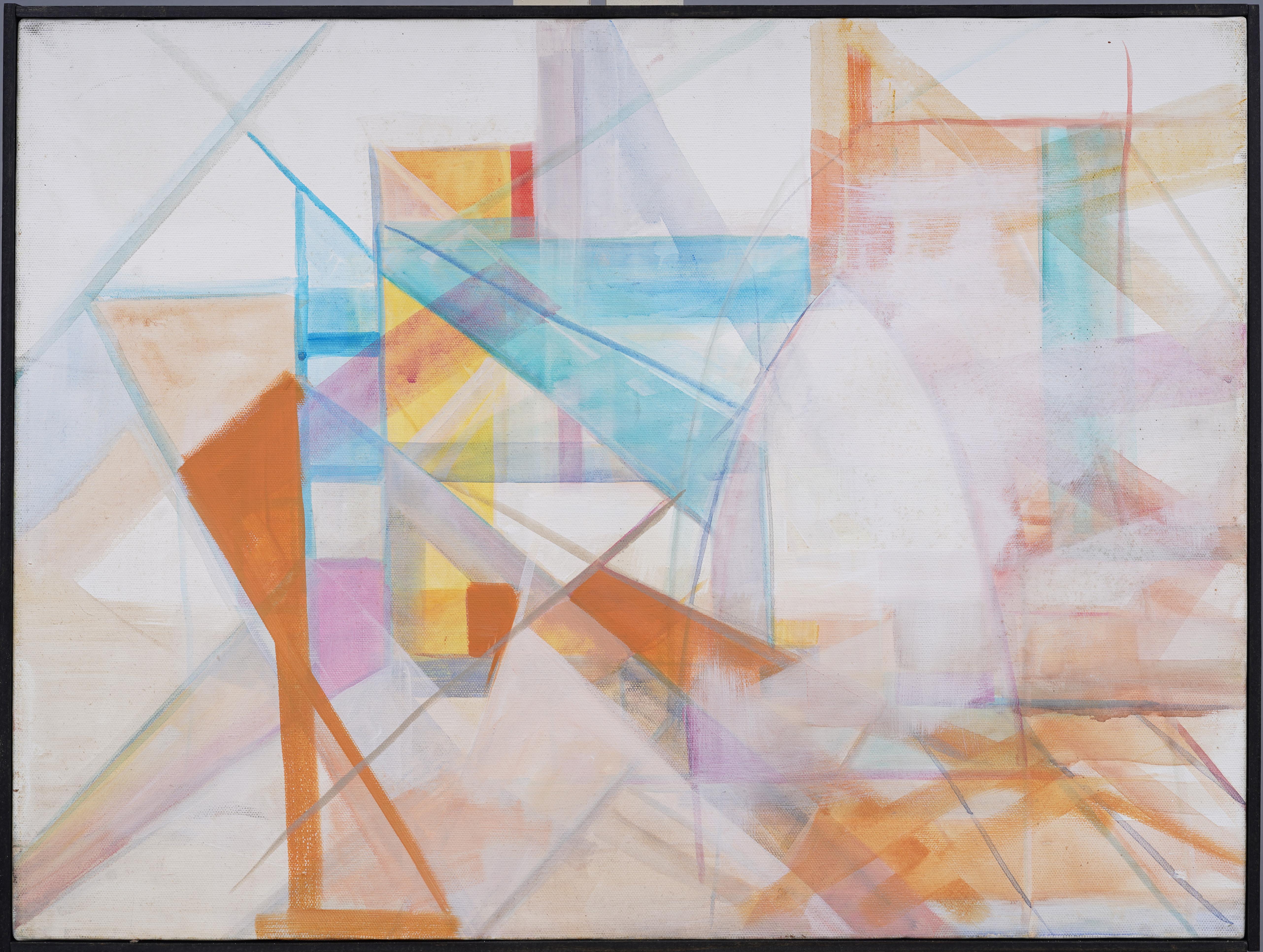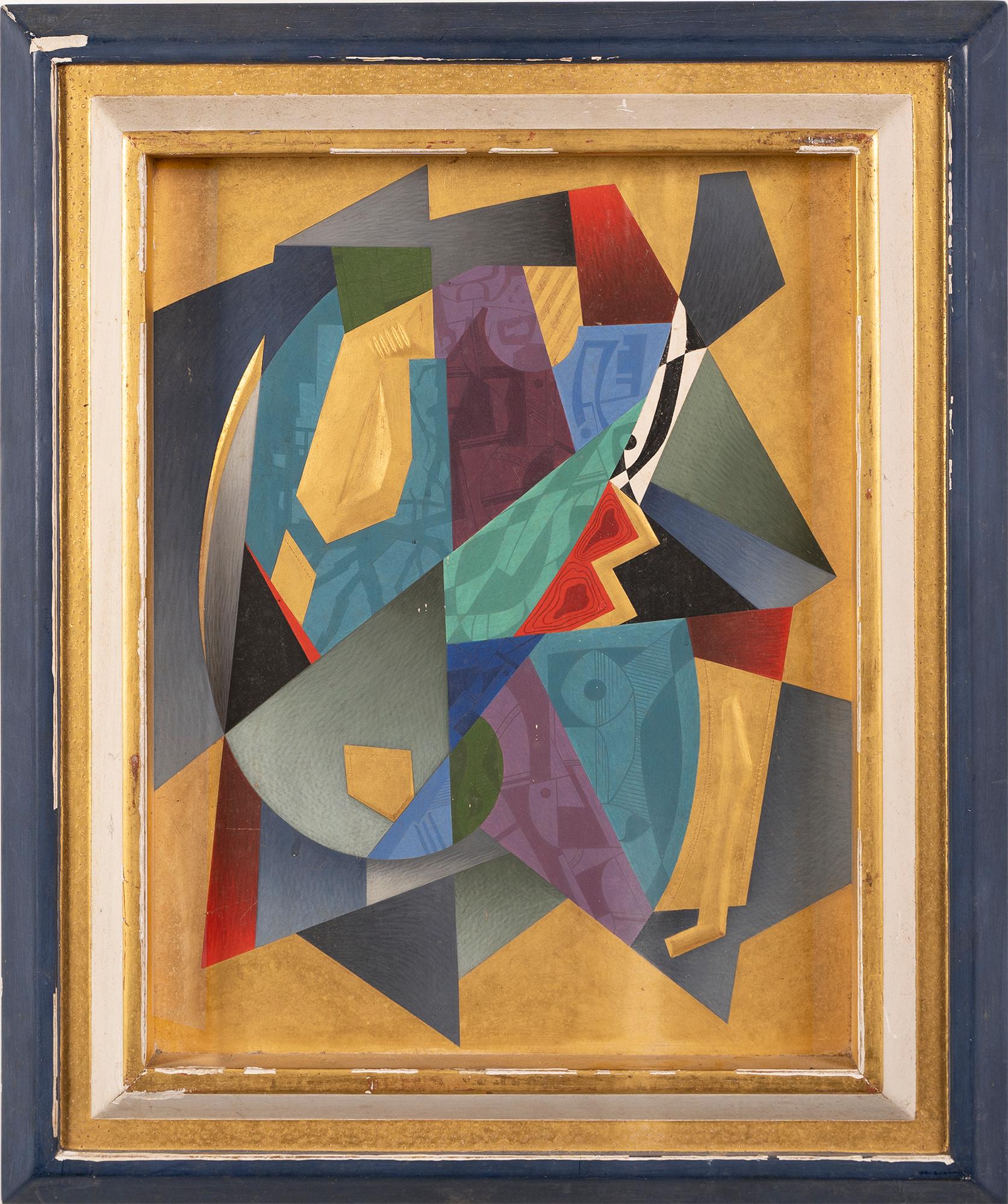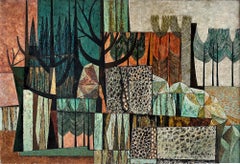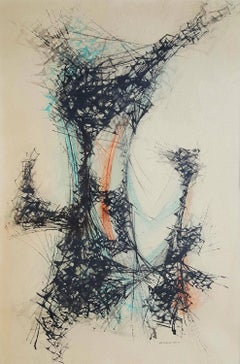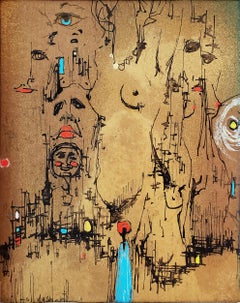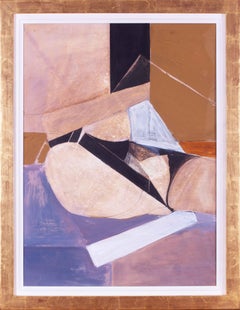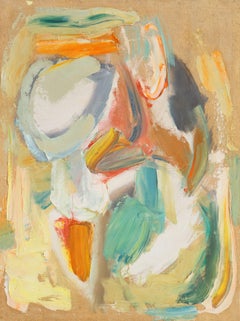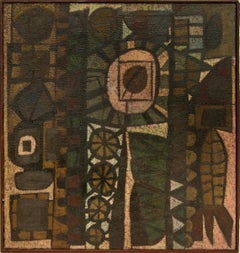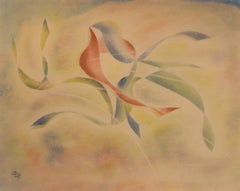Items Similar to Pre-War Abstraction - Modernism - Tan Bronze Tope - Nonrepresentational
Want more images or videos?
Request additional images or videos from the seller
1 of 11
Elsie DriggsPre-War Abstraction - Modernism - Tan Bronze Tope - Nonrepresentational1939
1939
$15,000
£11,157.46
€13,063.19
CA$20,930.09
A$23,421.36
CHF 12,229.53
MX$287,941.27
NOK 154,289.68
SEK 145,185.83
DKK 97,461.38
Shipping
Retrieving quote...The 1stDibs Promise:
Authenticity Guarantee,
Money-Back Guarantee,
24-Hour Cancellation
About the Item
Pioneering female abstract artist Elsie Driggs paints stylized abstract organic forms in a warm palette of orange browns and tope. She merges abstraction with some figuration. A structured face composed of lines and tone emerges from an orange background. It's 1939, and even though Driggs is not well known, she is preceding many of the marquee names of abstraction by a decade. Although under the radar, this is a major work and is titled on the back stretcher is " Egyptian Gothic." It features the artist's inventiveness with her fine pencil lines incorporated in flat washes of color and collage elements. Signed lower right and inscribed on frame verso with title, artist and the date of 1939. Provenance, Christie's, Freemans. Framed under glass..
Elsie Driggs (1898 – July 12, 1992 in New York City) was an American painter known for her contributions to Precisionism, America's one indigenous modern-art movement before Abstract Expressionism, and for her later floral and figurative watercolors, pastels, and oils. She was the only female participant in the Precisionist movement, which in the 1920s and 1930s took a Cubist-inspired approach to painting the skyscrapers and factories that had come to define the new American landscape. Her works are in the collection of the Whitney Museum of American Art, the Houston Museum of the Fine Arts, the Fine Arts Museums of San Francisco, the James A. Michener Art Museum in Pennsylvania, and the Columbus Museum of Art, among others. She was married to the American abstract artist Lee Gatch.
Career
Born in Hartford, Connecticut, Driggs grew up in New Rochelle, a suburb of New York City, in a family that was supportive of her artistic interests. After a summer spent painting with her sister in New Mexico in her late teens, she felt she had found her life's calling. At twenty, she enrolled in classes at the Art Students League of New York, where she studied under George Luks and Maurice Sterne, both of whom were charismatic, inspirational figures in her early life. She also attended the evening criticism classes held at the home of painter John Sloan. Driggs spent fourteen months in Europe from late 1922 to early 1924, drawing and studying Italian art. There she met Leo Stein, first in Paris and later in Florence, who became an important intellectual influence, and who urged her to study Cézanne. He also introduced her to the works of Piero della Francesca, the Renaissance artist for whom she felt throughout her life the greatest admiration.[1]
Driggs eventually settled in New York City, where she found representation with the progressive Charles Daniel Gallery.[2] (Advised that the old-fashioned and misogynistic Daniel would be unlikely to take on a woman artist, she signed the works she left for his consideration simply "Driggs" and waited to meet him in person until he had expressed his eagerness to include her in his gallery.)[3] In sympathy with those artists Daniel represented who were part of the burgeoning Precisionist movement, such as Charles Demuth, Charles Sheeler, George Ault, Niles Spencer, and Preston Dickinson, she too painted "the modern landscape of factories, bridges, and skyscrapers with geometric precision and almost abstract spareness."Impressionism and academic or Ashcan realism represented the past, in Driggs' view, and she intended to be resolutely modern. She was an attractive and engaging woman, but her demeanor belied a strong ambition and a clear sense of what it would take to make her mark in the New York art world. Driggs was part of the pre-eminent first group of Precisionist painters, including Demuth and Sheeler, who exhibited at the Daniel Gallery in the 1920s. Although a later group of Precisionist painters, including Louis Lozowick, Ralston Crawford and others, came on the American Art scene during the 1930s, Driggs felt that the style came to an end with the 1929 stock market crash.[5]
In 1926 she painted her most famous work, Pittsburgh, a dark and brooding picture now in the permanent collection of the Whitney Museum of American Art, which depicts the gargantuan smokestacks of the Jones & Laughlin steel mills in Pittsburgh. Its focus is an overpowering mass of black and gray smokestacks, thick piping, and crisscrossing wires with only clouds of smoke to relieve the severity of the image, yet it was an image in which she found an ironic beauty. She called the picture "my El Greco" and expressed surprise that viewers in later years interpreted the painting as a work of social criticism. Like the other Precisionists (e.g., Demuth, Charles Sheeler, Louis Lozowick, Stefan Hirsch), she was concerned with applying modernist techniques to renderings of the new industrial and urban landscape, not in commenting on potential dangers the overly mechanized modern world of 1920s America might present. If anything, Precisionism, like Futurism, was a celebration of man-made energy and technology. One year later, she painted Blast Furnaces, in a similar vein. As noted above, Piero della Francesca's mural depicting "The Story of the True Cross" in Arezzo, with its tubular, static and frozen forms was the major influence on Driggs' "Pittsburgh" (it may have been the major influence for "Blast Furnaces" as well).[7]
After Pittsburgh, Driggs' most acclaimed work was probably Queensborough Bridge (1927), now in the collection of the Montclair Art Museum, depicting shafts of light as rigid Futurist-style "lines of force" sweeping through the massive verticals of the East River bridge, a structure she had studied from her apartment window on Second Avenue. With this painting, art critic Forbes Watson wrote, "Miss Driggs waves goodbye to her old master Maurice Sterne and embraces for the moment the age of machinery."However, Driggs' use of "ray lines" (slender black lines that criss-cross the canvas, recall Precisionist works by Charles Demuth, and particularly his "My Egypt" (also from 1927). Although Driggs and Demuth exhibited at the Daniel Gallery, they never met.
In 1929 Charles Daniel gave Driggs a one-woman show, which included one of her sleekest and most compelling paintings, Aeroplane, now in the collection of the Houston Museum of the Fine Arts. The inspiration for the painting came from Driggs' first experience flying in 1928, when she traveled from Cleveland to Detroit by air.("Elsie Driggs, following the spirit of the age, has gone up in the air," commented an Art News reviewer.[11] Actually, Driggs went to Detroit to make studies from the Ford Motor Company's River Rouge Plant (Sheeler had preceded her there by a year). It was on this trip that she had made studies of a plane and sat next to the pilot on a shuttle trip from Cleveland to Detroit. This trip resulted in two Precisionist works, "Aeroplane" and "River Rouge." Unfortunately, Driggs' "River Rouge," a major Precisionist work, was lost in a fire.[12] Of course, River Rouge became Sheeler's best-known theme. However Sheeler would later create his version of a plane, "Yankee Clipper", in 1939 (collection of the Rhode Island School of Design, Providence, Rhode Island).
At the same time that Driggs exhibited her Precisionist machine age works at the Daniel Gallery, she was also creating a series depicting plant forms, both in pastel and oil, for the same gallery. In a group exhibition at the Daniel Gallery in 1924, "Chou" (collection of the Montclair Museum) a study of a cabbage, which was larger than life-sized, was displayed with works by Preston Dickenson, Andrew Dasburg and Thomas Hart Benton. The painting earned Driggs rave reviews by such prominent critics as Forbes Watson, who wrote," Elsie Driggs, a newcomer, is a distinct addition to the gallery's group, her painting of the spread out leaves of a cabbage being one of the most sensitive pieces of painting in the entire exhibition."[13] Perhaps Driggs' finest plant form is "Cabbage" of 1927 (private collection), which depicts an uprooted American cabbage swirling in space. This work is slightly larger and more dynamic than "Chou." Here Driggs shows more interest in depicting the crinkly cabbage leaves with botanical accuracy. The abstract, brown and white shaded background recalls contemporaneous paintings by Georgia O'Keeffe, who Driggs was known to meet at least on one occasion.[14]
Driggs also exhibited in group exhibitions at the Whitney Club, the Museum of Modern Art, and the Chicago Art Institute and in the Whitney Museum's first Biennial. Important newspaper critics such as Henry McBride and Margaret Breuning wrote favorably about her work. In 1929 McBride commented, "Elsie Driggs is capable of interesting us in anything in which she herself is interested."[15] When the Daniel gallery closed during the Depression, she was represented by the dealer J.B. Neumann and later by Frank Rehn.
In the 1930s, Driggs, after executing five major Precisionist works, abandoned the style – a decision that she may have later regretted. In fact, she concentrated more on "whimsical watercolors and figurative paintings as well as murals for the PWPA."[16] In 1935, Driggs married painter Lee Gatch. After two winters in New York, the couple moved to rural Lambertville, New Jersey. Driggs dedicated her efforts to Gatch's erratic career and to raising their daughter Merriman.[17] It was a loving but tumultuous marriage and their styles began to directly influence each other. Serendipitously, in 1940, their only child, Merriman, was playing with watercolors and began to rip paper and to paint the pieces. From this, Elsie got the idea of creating watercolor collages, which became a major focus of her work. She then began to create canvas collages, in which she would attach cutout pieces of canvas to a canvas, and then paint over them with oil paint. This idea was picked up by Lee, who began to incorporate the same process in both his paintings and his frames. These were adventurous works, which merit reconsideration.[18]
After Gatch's death in 1968, Driggs returned to New York City. Over the next two decades, she experimented with mixed media constructions and figurative paintings in pastels and oils. The rise of feminist art history brought her renewed attention, and she was the subject of a one-woman show at the Martin Diamond Gallery in 1980 and a retrospective at the New Jersey State Museum in Trenton in 1990. Curated by Thomas Folk, the retrospective exhibition, titled "Elsie Driggs, A Woman of Genius," traveled to the Phillips Collection in Washington DC. And Driggs created two final oil paintings in her Precissionist style, "The Javits Center" in 1986 (private collection) and "Hoboken" of the same year (private collection). She was included in many historical surveys of Precisionism.She continued to follow the contemporary art scene, admiring in particular the work of Helen Frankenthaler and Francis Bacon. She also sided with photographer Robert Mapplethorpe during his controversy at the Corcoran Gallery in Washington DC. At the time of her death in 1992 at the age of ninety-four, Driggs was considered the most underrated as well as the most long-lived of the Precisionist painters. She was interred at Woodlawn Cemetery in the Bronx, New York.[22][23] Thomas Folk, organized a memorial service and symposium which was held at the Whitney Museum of American Art on August 25, 2002. "Pittsburgh" was proudly displayed on the rear wall of the auditorium.
References
Biographical information for this entry is taken from Constance Kimmerle, Elsie Driggs: The Quick and the Classical (Philadelphia: University of Pennsylvania Press, 2008), pp. 13-55 and John Loughery, "Blending the Classical and the Modern: The Art of Elsie Driggs," Woman's Art Journal (Winter 1987), pp. 22-26.
Great Women Artists. Phaidon Press. 2019. p. 125. ISBN 978-0714878775.
Loughery, p. 22.
Driggs had come from a well-to-do family who resided on Central Park West, but because of the stock market crash, the Driggs family lost much of their affluence. As related by Driggs to art historian Thomas Folk, in several interviews he conducted with her circa 1985–1990, she felt that the Precisionist style had gone out of vogue with the Great Depression.
On the circumstances surrounding the painting of this work: Loughery, p. 24.
Thomas Folk, "Remembering Elsie" in Kimmerle, "Elsie Driggs," p.129. In the late 1970s, Driggs wrote an essay, "The Search for Pierro della Francesca" for a writing class at New York University. This essay was first published in Thomas Folk, "Elsie Driggs:A Woman of Genius," New Jersey State Museum, 1991, p. 51-52; and later also appeared in Kimmerle, "Driggs," p. 143-145.
Forbes Watson New York World, April 23, 1927.
Thomas Folk, Elsie Driggs, p.18.
Gail Stavitsky, Precisionism in America, 1915-1941: Reordering Reality (New York: Abrams, 1994), p. 111.
Art News, Vol. 28, no. 9, November 30, 1929.
Thomas Folk,"Elsie Driggs, p. 18.
Forbes Watson, "Painters form a Lively Group," New York World, February 17, 1924.
Folk, Driggs,p. 14.
Henry McBride, New York Sun, November 30, 1929.
"James A. Michener Art Museum – Art and Education in Doylestown, PA".
Elsie Driggs, James A. Michener Art Museum
Thomas Folk, "Remembering Elsie" in Kimmerle, "Elsie Driggs," p.130.
Kimmerle's book provides a complete list of all the exhibitions that included Driggs' work: Appendix, 2, pp. 134-142.
Loughery, pp. 25-26.
Folk, "Remembering Elsie" in Kimmerle, "Driggs," p. 131.
Inc, The Women's Project of New Jersey (1997-05-01). Past and Promise: Lives of New Jersey Women. Syracuse University Press
"Elsie Belknap Driggs Gatch (1898-1992) - Find A..." . Retrieved 2021-07-25.
Sources
Kimmerle, Constance. Elsie Driggs: The Quick and the Classical. Philadelphia: University of Pennsylvania Press, 2008. Includes essay by Thomas Folk, "Remembering Elsie,' pp. 127-133.
Loughery, John. "Blending the Classical and the Modern: The Art of Elsie Driggs," Woman's Art Journal (Winter 1987), pp. 22–25.
Stavitsky, Gail. "Reordering Reality: Precisionist Directions in American Art, 1915-1941". In: Precisionism in America, 1915-1941: Reordering Reality (Diana Murphy, editor). New York: Abrams, 1994.
Folk, Thomas. Elsie Driggs, A Woman of Genius, New Jersey State Museum, October 13, 1990- January 6, 1991; and traveling to the Phillips Collection, Washington DC, January 26- March 17, 1991.
- Creator:Elsie Driggs (1898 - 1992, American)
- Creation Year:1939
- Dimensions:Height: 18 in (45.72 cm)Width: 24 in (60.96 cm)Depth: 1 in (2.54 cm)
- Medium:
- Period:
- Condition:some slight fading to the art and matt is bowing and uneven. Frame has a some nicks and scatted gilt lose - would benefit from new matt and perhaps a new frame.
- Gallery Location:Miami, FL
- Reference Number:1stDibs: LU385313239842
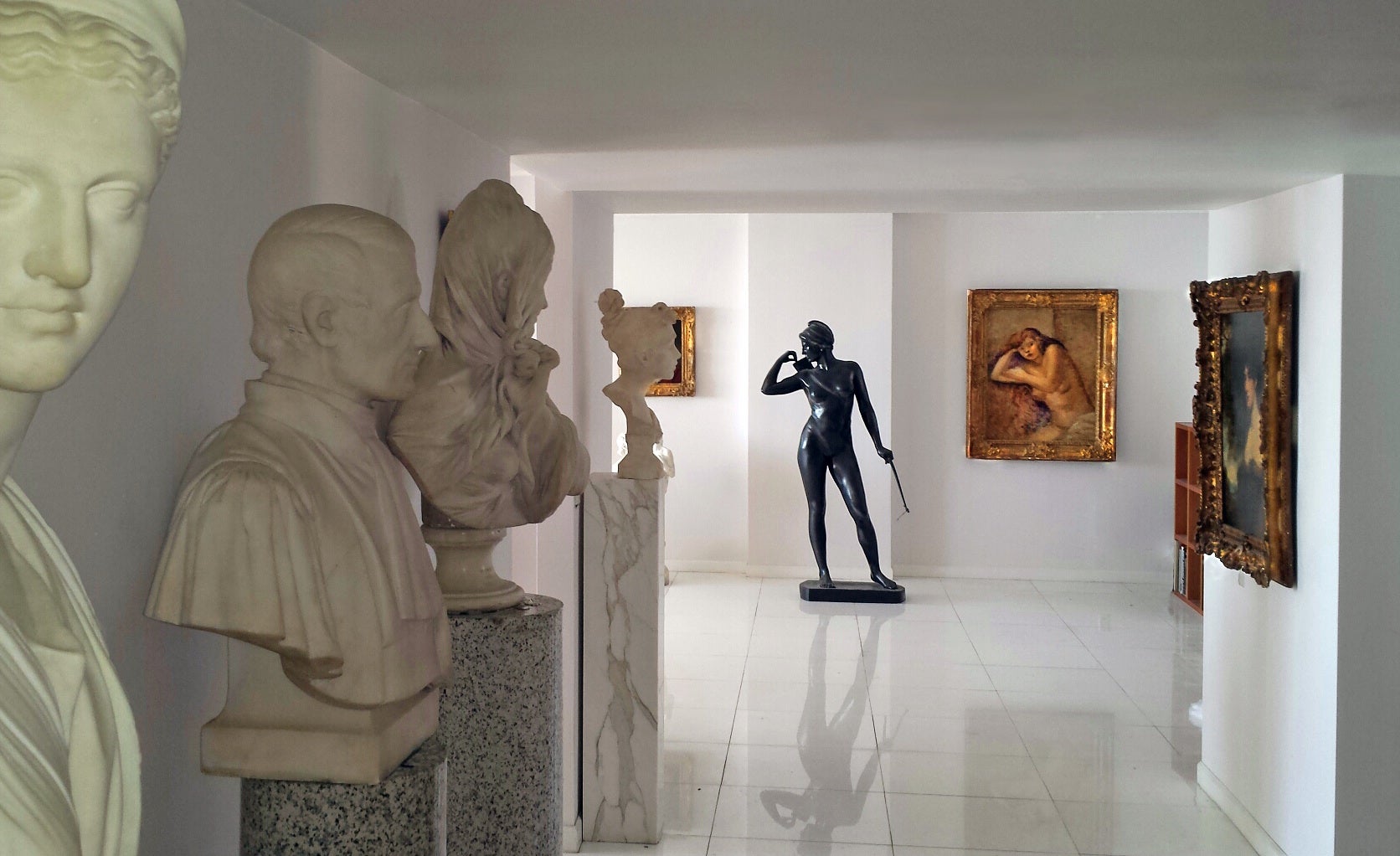
About the Seller
4.9
Vetted Professional Seller
Every seller passes strict standards for authenticity and reliability
Established in 2005
1stDibs seller since 2016
115 sales on 1stDibs
Typical response time: <1 hour
- ShippingRetrieving quote...Shipping from: Miami, FL
- Return Policy
Authenticity Guarantee
In the unlikely event there’s an issue with an item’s authenticity, contact us within 1 year for a full refund. DetailsMoney-Back Guarantee
If your item is not as described, is damaged in transit, or does not arrive, contact us within 7 days for a full refund. Details24-Hour Cancellation
You have a 24-hour grace period in which to reconsider your purchase, with no questions asked.Vetted Professional Sellers
Our world-class sellers must adhere to strict standards for service and quality, maintaining the integrity of our listings.Price-Match Guarantee
If you find that a seller listed the same item for a lower price elsewhere, we’ll match it.Trusted Global Delivery
Our best-in-class carrier network provides specialized shipping options worldwide, including custom delivery.More From This Seller
View AllLandscape Abstraction - Mid-Century - Twenty Paintings in One
Located in Miami, FL
When it comes to abstract painting, the creation date is important. At the height of Abstraction Expressionism, overlooked Academic Artist John Atherton created a wonderfully complex painting that embodies many of the characteristics of what was going on in Mid-Century American Art. The work is simultaneously abstract as it is representational. Like a Bento Box, it's divided into sections by dividers. On close inspection, each section stands on it's own as a beautiful mini-painting yet coalesces as part of the whole. From a distance, it is eye-pleasing, but as the view gets closer and closer, new structures and details gloriously reveal themselves. This is an important painting and not unlike the work of Joaquín Torres-García. It was done in the last year of the artist's life. Signed lower right. Canvas is relined. Framed size: 30 x 41.25. The work is best viewed with top gallery lights to bring out color.
Color will look different under different lighting conditions. Atherton exhibited at the famous Julien Levy Gallery in New York and his fine art is mainly associated with Magic Realism. He participated in the seminal 1943 Museum of Modern Art exhibition, American Realists and Magic Realists. The Museum of Modern Art has 4 Atherton paintings in its collection. As an Illustrator, Atherton did covers for the Saturday Evening Post, Fortune and Holiday Magazine...
Category
1950s Abstract Expressionist Abstract Paintings
Materials
Canvas, Oil
Improversation #3 - Early Abstraction
By John Sennhauser
Located in Miami, FL
Signed and dated lower right;
inscribed, Dated and Signed on Verso
Provenance: Ashley John Gallery
Category
1950s Abstract Expressionist Abstract Drawings and Watercolors
Materials
Watercolor
Improversation #3
By John Sennhauser
Located in Miami, FL
Gallery tags on verso. Work is frame an in very good condition.
Category
1950s Abstract Expressionist Abstract Drawings and Watercolors
Materials
Watercolor, Paper
Nude Figures, Metallic Gold Ground, African American Artist - Black Artist
Located in Miami, FL
Hollingsworth intertwines faces and figures along in black and red on a metallic ground. There are 3 nude figures in total. Black Arts Movement - Dreamy study of faces and nudes floating in a gold metallic sky. In the foreground the is a what appears to be an African figure in a long blue ground with bulbous red hat and then an indication of a mountainous horizon line. The right center is an indication of a sun.
Acrylic and metallic paint on board
Signed lower right
BIOGRAPHY:
Alvin Hollingsworth...
Category
1970s American Modern Nude Paintings
Materials
Acrylic
Guns, rifle and Shells Abstraction
Located in Miami, FL
An intriguing and complex composition composed of guns, rifles, ammo and a bullseye. Work is housed in a rustic Heydenryk frame.
Category
1940s Abstract Abstract Paintings
Materials
Gouache, Board
Early Abstract Expressionist - Black Mountain College Teacher, Franz Kline
By Emerson Woelffer
Located in Miami, FL
With Abstract Expressionist painting, one could argue that the earlier, the more historically important. This stunning non-objective action painting is characterized by vast swaths o...
Category
1950s Abstract Expressionist Abstract Paintings
Materials
Oil, Fiberboard
You May Also Like
Adrian Heath, British, mid 20th Century abstract in golds and browns
By Adrian Heath, 1920-1992
Located in Petworth, West Sussex
Adrian Heath (British, 1920 - 1992)
Golden Brown
Mixed media
signed ‘Heath 88’ (lower right)
73 x 54 cm.
Adrian Heath (1920–1992) was a 20th-century British painter.
Heath was born in Burma and attended Bryanston School in Dorset, southern England. In 1938, he studied art under Stanhope Forbes at Newlyn. In 1939 and 1945–47, he attended the Slade School of Art. He served in the RAF as a tail gunner in Lancaster bombers in World War II, but spent almost the entire war as a prisoner of war at Stalag 383. During this period he became friends with and taught fellow POW Terry Frost to paint.
In 1949 and 1951, he visited St Ives, Cornwall, where he met Ben Nicholson. In the early 1950s, he was also associated with Victor Pasmore and Anthony Hill. As such he became the main link between the emerging St Ives School and British Constructivism. He was also influenced by D'Arcy Thompson. In 1953 Heath published 'Abstract Painting: its Origins and Meaning' a slim but perceptive volume appraising the development of abstraction by the early moderns.
He exhibited at the Musée Carcassonne in 1948, and at the Redfern Gallery...
Category
20th Century Abstract Mixed Media
Materials
Mixed Media
'Abstract in Ochre, Rust and Jade', Mid-century Modernist American Woman Artist
By Dora Masters
Located in Santa Cruz, CA
Stamped, verso, on canvas with certification of authenticity for Dora Masters (American, 1916-2003), bearing stamped wax seal and painted circa 1955.
Provenance: Acquired from the a...
Category
Mid-20th Century Abstract Abstract Paintings
Materials
Canvas, Oil
Pods: Mid-Century Modern Abstract Oil Painting, American Modern, Earth Tones Art
By Edward Marecak
Located in Denver, CO
"Pods" is a captivating abstract oil painting created by 20th-century Denver artist, Edward Marecak (1919–1993). This original mid-century modern composition features a harmonious bl...
Category
Mid-20th Century Abstract Abstract Paintings
Materials
Oil
"Flow, " Rudolf Von Huhn, modern mid-century mixed media abstract, 1946
By Rudolf Von Huhn
Located in Wiscasset, ME
Born in San Francisco, California in 1884, painter and printmaker Rudolf Von Huhn studied and earned a degree in engineering in Germany and didn’t devo...
Category
1940s Modern Mixed Media
Materials
Mixed Media
Antique American School Modernist Abstract Cubist Framed Mid Century Painting
Located in Buffalo, NY
Nicely painted mid century abstract cubist oil painting. Great color and composition. Framed.
Category
1960s Cubist Abstract Paintings
Materials
Canvas, Oil
$1,020 Sale Price
20% Off
Antique American School 1930s NYC Surrealist Abstract Gold Gilt Oil Painting
Located in Buffalo, NY
Antique American school modernist mixed media painting. Oil on board with gold leaf assemblage, circa 1930. Unsigned. Image size, 13L x 17H. Housed in a period wood frame most li...
Category
1930s Abstract Abstract Paintings
Materials
Canvas, Oil
$15,800 Sale Price
20% Off
